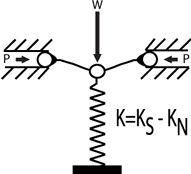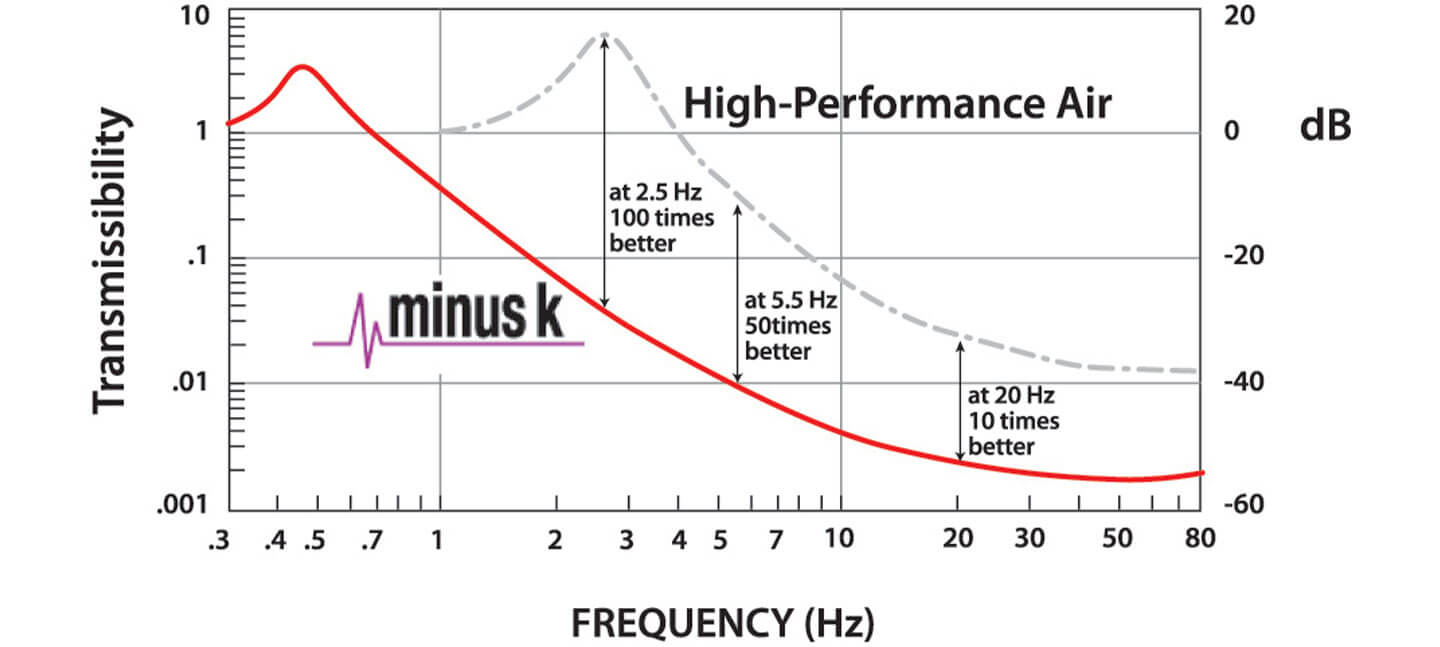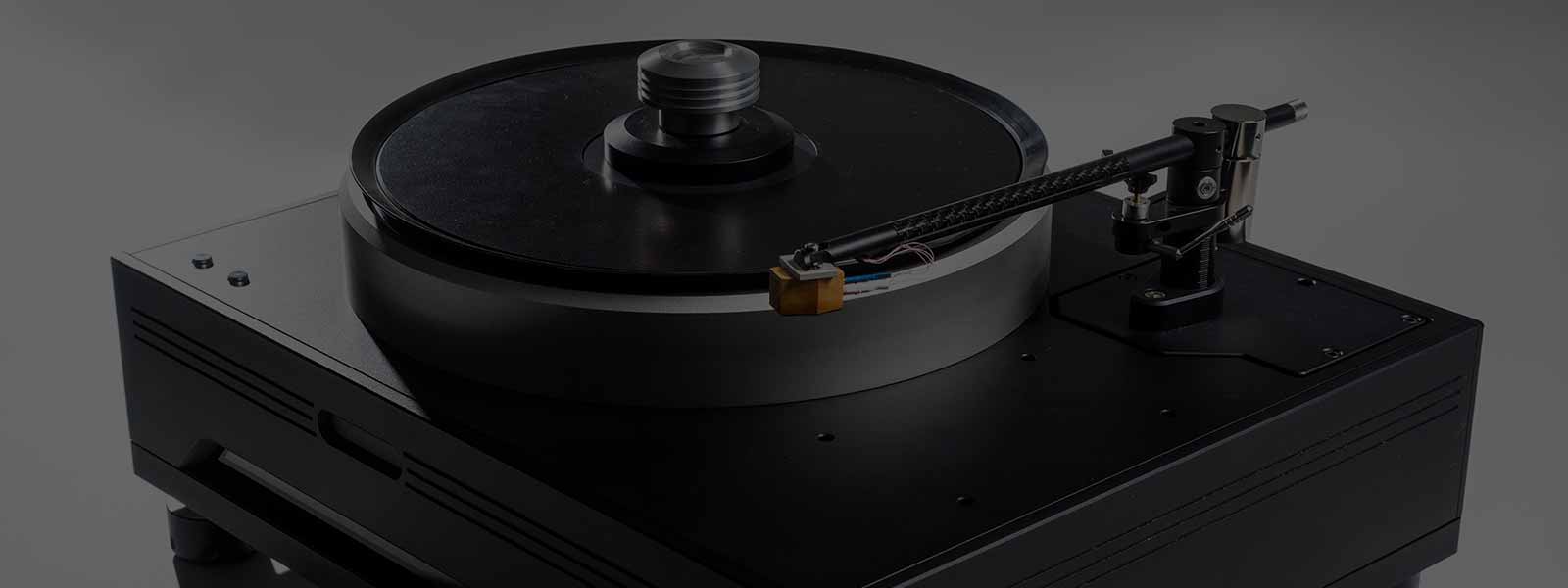Vibration Isolation
Our constant drive to improve on the current state of the art is based on the understanding that the design journey encounters new opportunities for breakthroughs in music reproduction often from outside the world of hi-fi. Sometimes the best ideas come from unexpected places!
We need to have an open mind to explore new sources of inspiration based on an accurate understanding of the underlying challenges in trying to extract an electrical signal from a mechanical device. For example, isolating a turntable from ground transmitted vibration has always been a challenge for turntable designers and a variety of solutions have been used, including suspension systems based on springs, rubber, plastic, foam, air, spikes, etc.
We looked outside the audio world and consulted with Dr David Platus from MinusK Technology USA who developed a revolutionary Negative Stiffness Mechanism (NSM) for electron and atomic force microscopy and other applications that are very sensitive to resonance.
Negative-Stiffness Vibration Isolators – How They Work
Vertical-motion isolation is provided by a stiff spring that supports the load of the Helix plinth and platter mechanism, combined with a negative–stiffness mechanism (NSM). The net vertical stiffness is made very low without affecting the static load-supporting capability of the spring.
Beam-columns connected in series with the vertical-motion isolator provide horizontal-motion isolation. The horizontal stiffness of the beam-columns is reduced by the “beam-column” effect. (A beam-column behaves as a spring combined with an NSM.) The result is a compact passive isolator capable of very low vertical and horizontal natural frequencies and very high internal structural frequencies.
Minus K® isolators typically use three isolators stacked in series: a tilt-motion isolator on top of a horizontal-motion isolator on top of a vertical-motion isolator. A vertical-motion isolator is shown in Figure 1.

Figure 1
It uses a conventional spring connected to an NSM consisting of two flexures connected at their inner ends to the spring and supported at their outer ends, and loaded in compression by forces P.
The spring is compressed by weight W to the operating position of the isolator, as shown in Figure 1. The stiffness of the isolator is K=KS-KN where KS is the spring stiffness and KN is the magnitude of a negative stiffness which is a function of the design of the flexures and the load P. The isolator stiffness can be made to approach zero while the spring supports the weight W.
A horizontal-motion isolation system consisting of two beam-column isolators is shown in Figure 2.


Figure 2
Each isolator behaves like two fixed-free beam columns loaded axially by a weight load W. Without the weight load the beam-columns have horizontal stiffness KS.
With the weight load the lateral bending stiffness is reduced by the “beam-column” effect. This behaviour is equivalent to a horizontal spring combined with an NSM so that the horizontal stiffness is K=KS-KN, and KN is the magnitude of the beam-column effect. Horizontal stiffness can be made to approach zero by loading the beam-columns to approach their critical buckling load.
Figure 3 shows a schematic of a negative-stiffness vibration isolator incorporating the isolators of Figures 1 and 2. A tilt pad serves as the tilt-motion isolator. A vertical stiffness adjustment screw is used to adjust the compression force on the negative-stiffness flexures thereby changing the vertical stiffness.
A vertical load adjustment screw is used to adjust for varying weight loads by raising or lowering the base of the support spring to keep the flexures in their straight, unbent operating position. This feature can be automated in single-isolator systems and to achieve automatic levelling in multiple-isolator systems.


Figure 2
Ultimate Vibration Mitigation System Without the Need for Air or Electricity!
Our research showed that the MinusK NSM technology was a far superior solution for a turntable’s requirement for six degrees of freedom ultra-low natural frequency vibration isolation.
Integrating the MinusK NSM into a turntable design produces the best resonance isolation solution ever experienced on a turntable. Virtually all top end designs are using suspension systems based on refined applications of air, rubber, springs, plastic, foam, air or spikes. When compared with the vibration mitigation performance of NSM, these solutions are vastly inferior. Another benefit is that neither air or electricity were required, eliminating the complexity and inherent issues that were associated with those design solutions.
Designing the turntable chassis simultaneously with the MinusK technology allowed us to accurately determine the “crossover” points where the MinusK low-frequency isolation needed to interface with the mid and higher frequency damping and control systems. This complete mechanical integration resulted in superior performance to simply placing a MinusK platform under a non-optimised turntable.

Micro Signal Architecture (MSA)©
Micro Signal Architecture© (MSA) is a cohesive design approach that uses the most advanced available techniques to remove physical vibration, mechanical vibration and electrical noise.
The application where the greatest research on micro-vibration mitigation has been conducted is the world of electron & atomic microscopy. Images at the nanoscale are extremely sensitive to external vibration, even under vacuum. Experiments utilizing sensitive equipment such as; Atomic Force Microscopes, Electron Microscopes and laser scanning systems, require the staff to stand still in the building and machinery to be disabled, when a sensitive image is captured by the microscope.
In actuality, even foot-steps several floors above can transmit through concrete structures and blur the images. Only with the installation of advanced vibration suppression and isolation can the images be retrieved in fine enough detail to show new insights. So how analogous is this to audio?
For analogue systems such as the audiophile turntable it is extremely relevant to the performance of the table. For vinyl playback, the enemy of any signal found in the mechanical groove by stylus tracing is also vibration and electrical interference!
Many audiophiles and music lovers lament the effectiveness or lack of isolation on turntables, even in cost-no-object designs. Our research has found that existing turntable suspension and isolation systems may not achieve the real-world performance objectives they claim and listeners often experience distortion, feedback, information blurring and over-weighted boomy bass response.
Modern homes are not designed for vibration control. In older homes with wooden floors these systems become unstable and do not stop footfall or feedback loops occurring (the classic tiptoe around the suspended turntable else your cartridge mis-tracks syndrome). This is predominantly due to the natural frequency of these suspension systems not being low enough (0.3hz-1.5hz).
The innovation in the Helix turntables relate to the ingenious way the NSM isolation technology is integrated. The turntable and NSM device form a fully acoustic and mechanically balanced system. The result is a precisely designed “mechanical crossover” that harmonizes the forces at play between the incoming external acoustic and mechanical vibrations and the self-generated internal vibrations caused by bearings, motor and chassis dynamics.
By using the latest software measurement technology for Chladni plate analysis and engineering ‘cymatics’, the team at Dohmann Audio has developed a complex chassis system that effectively damps vibration utilizing a semi-active topology.
Dohmann Audio extends this MSA thinking to the unique arm board damping technology that has been used in every Dohmann designed turntable since the late 1980’s. This technology extends the performance of an already world-class design to levels not achievable by other means.
TDS (Pre-Stress Accumulation and Release)
One of the major influences in the sound reproduction of vinyl play back is mechanical vibration. After all, turntables are mechanical devices. What if a “mechanical crossover” concept could be extended to create a smooth continuous pathway to channel vibrations away from critical areas on a turntable?
The Helix One and Two platforms use our proprietary TDS solution which forms a semi-active damping system to further lower the noise floor of the overall system. This technology uses a pre-stress accumulation release (PAR) strategy to mitigate vibrations inside the chassis caused by motor bearing and platter bearing noise. This technology creates a path of least resistance for these vibrations, channels them away from the critical signal path zones and dissipates the energy.
The primary source for energy dissipation is the material damping of higher frequency vibrations. Whilst frictional dissipation contributes to the system balance using constrained layer plates each plate has been designed using the latest Finite Element Analysis (FEA) and Finite Element Modelling (FEM) methods in advanced software (COMSOL).
Energy dissipation contributions at the time instant of node activation, amount to around 80% for material damping and 20% for frictional dissipation. There is additional dissipation not associated with any physical process (derived using Hilber-Hughes-Taylor calculations of motion).
Effective mitigation of such vibration further extends the performance of any tonearm mounted on the armboard. This semi active magnetic technology attenuates the last vestiges of noise generated by vibrating structures. The system does not require power or any servo feedback and has a larger restoring force than the physical drag caused by a stylus in the groove.
This geometrically locks the system into the chassis whilst it isolates the armboard from motor and bearing noise. This innovation was pioneered in the earliest Dohmann turntable designs first seen commercially in 1985 and has been thoroughly refined in the latest Helix chassis designs. The system is in effect an adaptive shock-absorber and control for energy dissipation in a flexible floating plate structure.
Pre-Stress Accumulation Release
The turntable is equipped with a device that constrains the relative slip between layers of plates. The strain accumulated in the structure locally is released as it occurs which results in conversion of a part of the strain energy to the kinetic energy of local, higher frequency vibrations. These higher frequency vibrations are then sunk into heavy damping materials which absorb and convert these to heat.
The equilibrium is restored rapidly to allow the structure to return to the initial state by means of a gradual release of the pre-stress accompanied by the frictional dissipation in the contact surfaces. This architecture is used as a Mechanical Crossover to selectively reduce each band of frequencies.
The MinusK NSM system absorbs and isolates low frequency vibrations up to 100Hz and the Mechanical Crossover then uses the complete constrained layer plates to absorb mid-band vibrations. Higher frequency artefacts are then focussed and dissipated in the PAR system.
From this method we learn the shape and weight of the components influence acoustic behaviour under vibration. Therefore, selection of materials and the suspension elements used determines the crossover frequency and effectiveness!
By extending the mechanical crossover concept to the Helix platforms, physical zones can be defined on the infrastructure that focused vibrations away from key areas (platter, bearing, motor, tonearms, floor modes), establishing a smooth continuous pathway to channel vibrations away from critical areas on the turntable.
The Helix platforms have been designed to reject low frequency vibrations coming up from the floor by using the MinusK NSM isolation system and drive higher order vibrations generated through motor noise away from the bearing and platter via a complex coupling to the chassis. For these higher order vibrations local isolation, absorbing, redirecting and suppression technologies are employed including semi-active decoupling from motor vibration.
Helix turntables have been designed to operate flawlessly in non-ideal environments suffering from floor borne vibrations such as older houses with wooden floors, upper floors, attics and any external vibrations which are carried through buildings – even those made from concrete steel, and brick.
Measurement and Visualisation Techniques are used which enable the Dohmann engineering team to ‘see’ these vibrations in real life, especially how they move and where they ‘collect’ on a chassis under real life operating conditions.
HTAD (High Torque Adjustable Drive)
The precision motor industry is changing rapidly to embracing a software driven architecture. Helix technology is taken from the latest developments in sub-micron servo drive systems for precision optics and adapted by our engineering team to deliver superior motion control to the Helix turntables.
The Helix motor control system is a digital closed loop servo with greater than 16bit resolution. Absolute positioning reading occurs over 120,000 discrete positions of the rotor per revolution. The motor spins several hundred times to achieve one revolution of the platter thus increasing the system resolution by an order of magnitude over a direct drive topology.
In layman’s terms, this means at 33/45 rpm platter speeds we have an incredibly high number of checks on the speed stability per second. This information is fed to a very fast microprocessor in the servo control and our custom written software then defines the stiffness and the ballistics of the system and responsiveness of the servo loop. Different inertia/force ratios can be programmed to yield different sonic signatures and sound dynamics.
The table can act like a high torque direct drive or like an underpowered low torque design depending on servo programming. Torque force can be adjusted to suit sonic palettes and the frequency of the drive shifted to areas that are better handled by the mechanical design and vibration control.
Cogging is prevented by a proprietary coil design that smooths the motor to vanishing low levels of vibration. Our motor design team has delivered extremely low motor noise on the Helix platform. We have not found any comparable system able to attain similar results.
The speed is factory set for 33 and 45 and does not need adjustment in normal operation. However, if a user wishes to adjust the reference speed a software application via a computer allows adjustment. It is also able to be securely connected to our service technicians for diagnostics and firmware / software upgrades.
The Plinth
The 120mm (4 inch) plinth is made from precision CNC aircraft grade aluminium and structural alloys and weighs close to 50 kg (111 Lbs) when assembled. It is connected by a series of interlocking plates which are fitted closely to the MinusK suspension system and allow for the mounting of the sub-systems such as the motor, bearing and the tonearm combinations. A laminated glass plate is used to add ballast and lower the center-of-mass. This glass plate provides visual access to the MinusK suspension for performance monitoring.
The Platter
The platter is a four layer design and is the result of many years of research. The Mat is a special elastomer with a fibre reinforcement chosen for its damping properties and ability to protect the LP surface under clamping pressure. The upper platter is a moulded composite sandwich made of a 5000 series aluminium alloy base plate and a 10mm thick composite resin matrix with acoustic refraction properties that resemble vinyl. This is bonded to a 5000 series base alloy composition that includes magnesium, manganese, titanium with Silicon Carbide. This composition was chosen for its high damping coefficient.
The platter incorporates an air gap between the upper and lower platter and weighs 15kg (33lbs). The lower platter is constructed with an Aluminium alloy outer shell with a metal matrix composite system inside. This provides the unique properties of increased mechanical strength as well as beneficial vibration characteristics. The hybrid design uses the Aluminum 5083 as the base metal and the Silicon Carbide and other compounds as the reinforcement material. The composition of each of the reinforcement materials plays a particular part in affecting the damping characteristics or mechanical strength. During development, the results of vibration tests carried out on this hybrid Aluminium metal matrix composite plate as well as the results obtained from computational analysis using software were interpreted to effectively determine the damping ratio, frequency, magnitude, phase angle and ultimately the dynamic behaviour of the composite materials used in this appliction.
Helix turntables use an Edge Damping Ring which damps the platter and LP edge and a damping mat to interface with the LP. The Spindle/Spindle Housing is engineered for high reliability and ultra-low noise operation. Specially sourced Maraging Steel is used to provide the desired precision and low thermal & flex characteristics. Located at the bottom of the spindle, a ceramic ball is used for trouble-free operation on a quiet thrust pad. The high-tech lubrication system is sourced from the aeronautical engineering field to ensure low noise operation.
The Record Clamp
The record clamp is designed for ease of operation and secures the LP effectively on the platter surface and flattens even severe warps in poor quality LP’s.
The clamp is a multi-piece design which has a reduced damage profile in the event a user accidentally drops the clamp onto an LP during operation.
The Motor & Belts
A Swiss-manufactured precision single spindle high-torque motor featuring zero cogging is used. The motor can supply up to 100 watts of power for the most demanding control needs. By using sophisticated control software, the belt system is gently started and bought to rest to avoid premature wear. Speeds are factory set and highly accurate. The Helix One series has a speed adjustment feature located on the PowerBase for final in-room tweaking. This is used to counter the real-world speed variations caused by temperature, humidity, lubrication variables, etc.
Dual high damping o-ring belts are provided for stable drive transmission. The use of two belts is a Dohmann Audio innovation.
Armboard Assemblies
The Helix One supplies two armboards (for dual arms) that are removable and can be pre-drilled for most commercially available arms or left blank for future use and the Helix Two supplies one armboard facility. The armboards are able to be fitted or removed externally with arms mounted. No need to dismantle and recalibrate. The chassis has a damped tubular cross-section underneath which precisely locates the armboards relative to the bearing and platter. This provides a very rigid system with minimal flex and movement.

